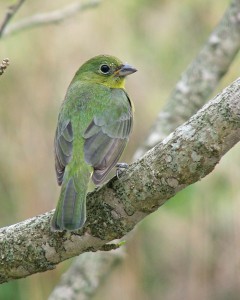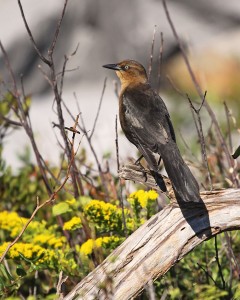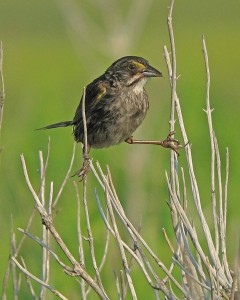By MEGAN SHARP
Pat Moore has been birding for more than 50 years — and at 84 years old she is still active in birding activities on the Outer Banks.
“I remember searching for birds before we had the technology that allowed the playing of bird calls while in the field,” she recalls. “I learned their songs by listening to them until I could remember each one. Then I would go home, put a record on my turntable, and match the songs to my memory of them. I can still identify most of them by memory. Much of my pleasure birding in the field comes from hearing and recognizing songs while envisioning the singers.”
The North Carolina coast is widely known for dozens of species of gulls, waterbirds and shorebirds. However, many who visit the region miss the chance to see — and hear — some of our state’s most hidden treasures: songbirds of the coast.
Whether deep within maritime forests or in undergrowth and trees a few miles inland or even on the Outer Banks, these songbirds are worth going a little out of the way to find.
PAINTED BUNTING
Seeing a painted bunting for the first time is an experience few birders forget. John Carpenter, coastal landbird biologist for the N.C. Wildlife Resources Commission, says that its brilliant plumage “makes it the kind of bird you’d expect to see in a tropical rainforest, and yet it can be seen throughout the coastal region of North Carolina, down to Florida, as well as across the Gulf Coast.”

Female painted buntings and juveniles are green. Photo by Jeff Lewis.
Though the painted bunting is known more for its stunning feathering, its song is almost as beautiful. It has a bright, pleasant sound, similar to a warbler’s call, with a sharp chip note at the end.
The male painted bunting has a vibrant indigo streak along the top of its head, with a bright red underbelly and patches of lime green and yellow along its back. Females (and juvenile males), though significantly less colored, still sport a bright green back with a pale yellow underbelly.
Painted buntings are a monogamous species. They nest in low vegetation, such as shrubs, and generally lay three to four light gray eggs, speckled with brown. The female incubates the eggs for about 11 to 13 days. The young birds are usually ready to leave the nest at around two weeks old.
The best time of year to see these birds along the coast is in the summer. They can be found in open brushlands, hedges, yards and thickets. Painted buntings are ground foragers, so look for them in low-level areas.
BOAT-TAILED GRACKLE
People have always had mixed feelings about grackles. Their pervasive and seemingly destructive habits, along with their large stature and loud, piercing song — a serious of sharp, guttural thrills of chek notes and whistles — have all combined to make them less than popular.
“Their tails imitate the stern of a boat, large and fanned out behind them,” says Jeff Lewis, garden and greenhouse manager for the Elizabethan Gardens in Manteo.
“It’s hard to believe that they can actually fly with such odd proportions. Between that and their obnoxious song, you can’t miss them.”

A female boat-tailed grackle is lighter in color, with a brown head. Photo by Jeff Lewis.
However, most birders would say that these birds are simply misunderstood. In her book, titled 100 Birds and How They Got Their Names, Diana Wells says that, Swedish immigrants who sought to farm in America’s heartland were constantly doing battle with these “corn thieves.” Grackles flooded their farms in numbers that made it impossible to see the ground where they were feeding. The farmers soon realized, however, that the grackles were eating the worms and grubs that did far more damage than the birds ever did. The corn lost was eventually considered to be their “tithe” to the birds.
Grackles often nest in reeds or small shrubs that are over the water. The coastal waters of North Carolina are prime habitats for them. They lay one to five eggs that are generally light blue with brown and black scrawls. Fledglings that fall out of the nest and into the water can swim well for short distances, using their wings as paddles.
Though the males appear to have a plain black coloring, the boat-tailed grackle actually possesses an iridescent quality to their feathering. When seen up close in the sunlight, their color changes from shimmering blues and purples to greens and bronze. This remarkable sight was enough to make John Audubon write that “no painter, however gifted, could ever imitate them.”
SEASIDE SPARROW
As the name implies, the seaside sparrow is “found only on the Atlantic and Gulf coasts,” Lewis says. “This makes North Carolina’s coast a prime place to see them.” It is a stocky songbird, with a short tail and large bill. Its song matches its size — short and muffled with a piercing buzz at the end.

The seaside sparrow has dull coloring, except for the streaks of yellow around its eyes. Photo by Jeff Lewis.
The seaside sparrow, like most sparrows, is rather drab, with olive-gray feathering, black whisker marks and a white throat. However, near both of its eyes, the seaside sparrow has bright streaks of vibrant yellow. In her book, Wells indicates that its French name, moineau, means “a monk,” given for its dull, cowl-like feathering.
The English name “sparrow” comes from the Old English word spearw, which translates to “a flutterer,” and accurately describes its quick, haphazard movements. The bird is built for speed and endurance, because it generally nests a good distance away from its food source.
Seaside sparrows usually lay two to five eggs per clutch and tend to nest in shrubs. The eggs are bluish white with blotches of brown, which are generally more concentrated at the larger end.
They can best be seen on the coast of North Carolina in the summer months. Look in tidal reeds, rushes and salt marshes, especially those with spartina grass.
THE NORTH CAROLINA BIRDING TRAIL
Organizers of the North Carolina Birding Trail describe it as the greatest asset to birders in the state. This trail links 310 birding sites from the coast to the mountains. The sites range from national parks and bird sanctuaries to private residences. The requirements? They have to have lots and lots of birds.
Lena Gallitano, former president of Wake Audubon Society, was a leader among the team who introduced the birding trail to North Carolina. “It’s the only trail in North Carolina that connects the entire state and is available for the public to go out into nature,” she says. “It’s a wonderful addition to our state.”
The North Carolina Birding Trail has three guidebooks to help direct birders along the trails. Each book — one each for the mountains, piedmont and coast — gives detailed information about each site, as well as what birds can be seen.
The birding trail not only provides valuable resources for birders and conservationists, but also helps support economic development. Local restaurants and shops located around various sites have teamed up with the birding trail to offer services to visiting birders. Visitors are encouraged to leave “birder calling cards,” which are printed in the back of each guidebook, to let business know that they were referred there by the birding trail resources.
“It is providing a service to birders, helping local economies and promoting wildlife habitat conservation,” says Jack Thigpen, North Carolina Sea Grant extension director. He was part of the group that helped create the birding trail.
CONSERVATION IS KEY
Currituck County’s name reflects its avian tradition — it was derived from the Native American word “coratank,” meaning “wild geese.” There was a time when locals claimed to see so many wild birds in flight that they blackened the sky with their wings.
Today, Currituck is still full of little treasures for birders, conservationists and tourists alike. Efforts include the Donal C. O’Brien, Jr. Audubon Sanctuary and Center of Pine Island in Corolla. Though still in its early stages, this 3,000-acre sanctuary eventually will be equipped with a large center where visitors can learn about the island, marsh, Currituck Sound and the birds that inhabit it.*
Walker Golder, the deputy state director for Audubon North Carolina, says that this endeavor “will be a place where we will engage the community and conduct scientific research, which will hopefully result in improved protection efforts for the Currituck area.”
ADDITIONAL INFORMATION AND LINKS
• Audubon North Carolina, nc.audubon.org: This website gives extensive information on local birding events, conservation and how to join your local chapter.
• The Cape Fear Audubon Society, www.capefearaudubon.org: This site has information on birds, environmental education and birding events along the southern coast.
• Painted Bunting Observer Team, paintedbuntings.org: Developed by a group of University of North Carolina Wilmington researchers and citizen scientists dedicated to preserving this amazing bird, this site provides a detailed overview about the status of the painted bunting in North Carolina.
• The North Carolina Birding Trail, ncbirdingtrail.org: Gather information about various sites along the birding trail and the specific birds that can be seen in North Carolina. Trail guides can be ordered from UNC Press at: uncpress.unc.edu or from your local bookstore.
• The Cornell Lab of Ornithology, www.allaboutbirds.org: This site acts as a virtual, interactive encyclopedia on birds. Search hundreds of different species of birds, listen to each of their sounds, stream live video of young hawks as they hatch, and flip through stunning photos of falcons in flight.
BEGINNER’S WARM WEATHER BIRDING KIT
According to Jack Thigpen, North Carolina Sea Grant’s executive director and a birding hobbyist, the best way to get started in birding is to go with a group or someone who is experienced.
“I always learn a lot about identifying by sight and sound from people who know more,” Thigpen advises. “I also recommend searching online for your locality with the word ‘birding.’ You might be surprised how many local resources are available.”
A basic kit would include a good pair of binoculars, a birding field guide, a camera and notepad. Also, don’t forget sunscreen and insect repellent, as well as a hat. And finally, wear comfortable all-terrain boots and long pants.
* Update, as of April 3, 2020: Please note that the Pine Island Audubon Sanctuary does not have a visitor center and is generally closed to the public. However, it does offer a nature trail that is open to everyone from dawn to dusk, 365 days a year. Park at the Pine Island Racquet and Fitness Center on N.C. 12 for easiest access. Learn more at pineisland.audubon.org/visit/landing/nature-trail.
This article was published in the Summer 2012 issue of Coastwatch.
For contact information and reprint requests, visit ncseagrant.ncsu.edu/coastwatch/contact/.
